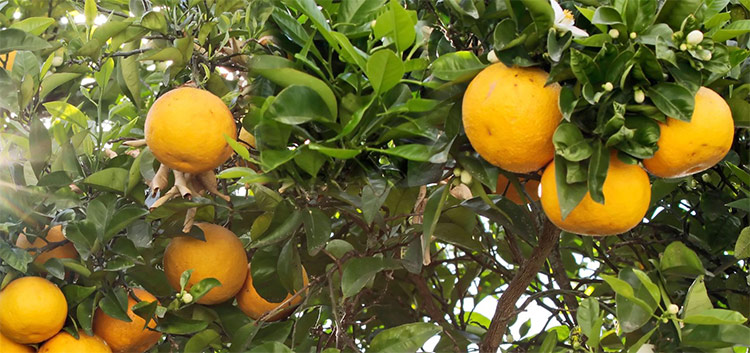Bitter Orange Essential Oil
Citrus aurantium

Description
As the name implies, Bitter Orange Essential Oil possesses a bitter, citrusy aroma reminiscent of a cross between the sweetness of Sweet Orange Essential Oil and the slight tartness of Grapefruit Essential Oil.
Bitter Orange Essential Oil is generally cold pressed from the rind of the Bitter Orange fruit. The bitter orange comes from the same tree, Citrus aurantium, that brings us Neroli Essential Oil and Petitgrain Bigarade Essential Oil.
Steffen Arctander describes the aroma of Bitter Orange Essential Oil as being "...fresh and yet "bitter" in the sense of "dry", but with a rich and lasting, sweet undertone. There are notes which remind of bergamot, grapefruit and sweet orange, but overall, the odor is distinctly different from that of other citrus oils. It is a different type of freshness, a peculiar floral undertone which occasionally shows indolic notes, and a comparatively good tenacity." [Source: Steffen Arctander, Perfume and Flavor Materials of Natural Origin (Reprint Edition. Elizabeth, NJ: Pathfinder., 2017), 480.]
I particularly like using Bitter Orange Essential Oil in blends intended to help combat anxiety and feelings of fear and extreme dread.
Bitter Orange Essential Oil is phototoxic. Refer to the safety information mentioned below.
Bitter Orange Essential Oil Benefits and Uses
- Anxiety
- Improvement of Mood
- Colds
- Constipation
- Dull Skin
- Flatulence
- Flu
- Gums
- Mouth
- Slow Digestion
- Stress
Sources: Julia Lawless, The Encyclopedia of Essential Oils (Updated Edition) (London: Harper Thorsons, 2014), 151-152. Jennifer Peace Rhind. Essential Oils Fully Revised and Updated 3rd Edition (Kindle Locations 12443-12445), Jessica Kingsley Publishers. Kindle Edition.
Botanical Name
Plant Family

Common Method of Extraction
Cold Pressed/Expressed
Plant Part Typically Used
Color
Yellowish Orange to Greenish Orange
Consistency
Thin
Perfumery Note
Top
Strength of Initial Aroma
Medium
Aromatic Description
As the name implies, Bitter Orange Essential Oil smells like a cross between the sweetness of sweet orange oil and the slight bitterness of grapefruit oil.
Major Constituents
- Limonene
- B-Myrcene
- Linalool
- Bergapten
See Essential Oil Safety for a more complete list of typical constituents.
Source: B.M. Lawrence, Essential Oils 1981-1987 (Wheaton: Allured Publishing, 1989), 39-40. P. Dugo, L. Mondello, E. Sebastiani, et al., Identification of Minor Oxygen Heterocyclic Compounds of Citrus Essential Oils by Liquid Chromatography-Atmospheric Pressure Chemical Ionisation Mass Spectrometry. (Journal of Liquid Chromatography & Related Technologies 22, 1999), 2991-3005. B.M. Lawrence, Progress in Essential Oils, Number 2. (Perfumer & Flavorist 25, 2000), 46-49. SCCP, Opinion on Furocoumarins in Cosmetic Products. (Scientific Committee on Consumer Products, 13-Dec.-2005), SCCP/0942/05. Sources cited in Robert Tisserand and Rodney Young, Essential Oil Safety (Second Edition. United Kingdom: Churchill Livingstone Elsevier, 2014), 371.
Bitter Orange Essential Oil Safety Information
Bitter Orange Essential Oil is phototoxic. Tisserand and Young recommend a dermal maximum of 1.25% to avoid risk of phototoxic reaction. Avoid using Bitter Orange Oil that has oxidized due to a greater risk of skin sensitization. Reading Tisserand and Young's full profile is recommended. [Robert Tisserand and Rodney Young, Essential Oil Safety (Second Edition. United Kingdom: Churchill Livingstone Elsevier, 2014), 87, 371.]
General Safety Information
Do not take any oils internally and do not apply undiluted essential oils, absolutes, CO2s or other concentrated essences onto the skin without advanced essential oil knowledge or consultation from a qualified aromatherapy practitioner. For general dilution information, read AromaWeb's Guide to Diluting Essential Oils. If you are pregnant, epileptic, have liver damage, have cancer, or have any other medical problem, use oils only under the proper guidance of a qualified aromatherapy practitioner. Use extreme caution when using oils with children and be sure to first read the recommended dilution ratios for children. Consult a qualified aromatherapy practitioner before using oils with children, the elderly, if you have medical issues or are taking medications. Before using this or any essential oil, carefully read AromaWeb's Essential Oil Safety Information page. For in-depth information on oil safety issues, read Essential Oil Safety by Robert Tisserand and Rodney Young.
Shelf Life
Important Information About the Profiles
The essential oil information provided on AromaWeb is intended for basic educational purposes only. The references to safety information, test results, constituents and percentages is generalized information. Essential oils can vary greatly in composition. The data is not necessary complete and is not guaranteed to be accurate. The essential oil photos are intended to represent the typical and approximate color of each essential oil. However, essential oil composition and color can vary based on harvesting, distillation, age of the essential oil and other factors. Profiles for several CO2 Extracts and absolutes are included within the directory, and are denoted as such.
